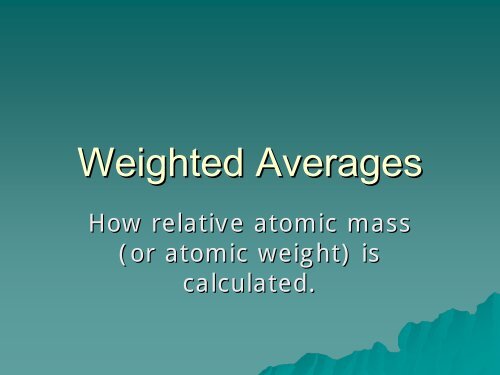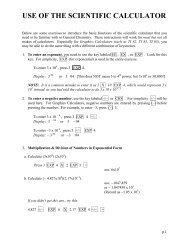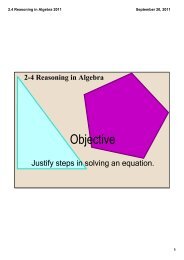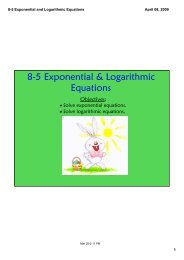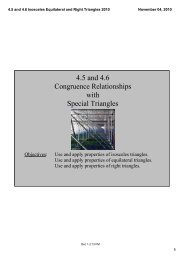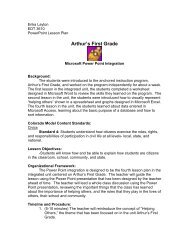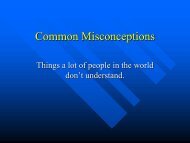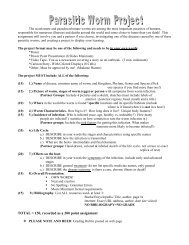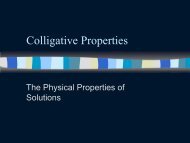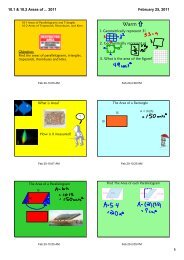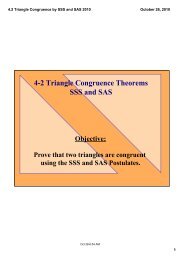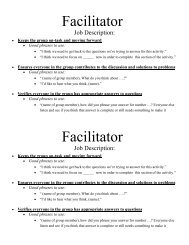Weighted Averages and Relative Atomic Mass PowerPoint
Weighted Averages and Relative Atomic Mass PowerPoint
Weighted Averages and Relative Atomic Mass PowerPoint
- No tags were found...
You also want an ePaper? Increase the reach of your titles
YUMPU automatically turns print PDFs into web optimized ePapers that Google loves.
<strong>Weighted</strong> <strong>Averages</strong>How relative atomic mass(or atomic weight) iscalculated.
Simple Average You know from your math classesthat averaging numbers (finding themean) ) is fairly easy. One simply adds all the numbers inthe set together <strong>and</strong> divides by thenumber of entries.
An Example Let’s s imagine a classof 10 students took a10 point quiz. Here are the scores: Calculate the averagescore. 7.4 is correct. Did any of thestudents actually get7.4 points? 10 10 9 8 8 8 7 6 6 2
<strong>Weighted</strong> Average There is another way to solve such aproblem. Rather than calculating a simpleaverage, we will calculate a weightedaverage. A weighted average is calculated asfollows: Σ(relativeabundance) x (value of data class)
<strong>Weighted</strong> Average The Greek letter sigma (Σ)() means“sum of”. Let’s s define the data classes first. There were several different scoreson the quiz. Each type of score is adata class. There were 10s, 9s, 8s, 7s, 6s <strong>and</strong> a2.
<strong>Weighted</strong> Average Next we need the relative abundanceof each. <strong>Relative</strong> abundance is the number ofitems in the data class/total entries. There were 2 scores of 10 <strong>and</strong> 10total scores. 2/10 = 0.2 The relative abundanceof 10s is 0.2.
<strong>Weighted</strong> Average There was only 1 score of 9; relativeabundance = 1/10 = 0.1 There were 3 scores of 8. RA = 0.3. Only 1 score of 7. RA = 0.1, etc. A table might make this easier tovisualize.
<strong>Weighted</strong> AverageScore<strong>Relative</strong> Abundance10 0.29 0.18 0.37 0.16 0.22 0.1Total 1.0The total of the relative abundances must be1.0 (or very close.)
<strong>Weighted</strong> Average Because the data classes occur withdifferent frequencies, , we cannotsimply add the values of the dataclass together. We must give each data class aweight. . (Thus the term ‘weighted’average.) Weighting each class eliminates theneed for the simple average we usedearlier.
<strong>Weighted</strong> Average Average quiz score = Σ(testscores) x (relative abundance) 10•(0.2) + 9•(0.1) 9+ 8•(0.3) 8+7•(0.1) + 6•(0.2) 6+ 2•(0.1) 2 2.0 + 0.9 + 2.4 + 0.7 + 1.2 + 0.2 =7.4 This is the same result we obtainedearlier.
Why bother? At this point you may be saying,“That method looks like a lot ofwork. Why would I want to use it?” We probably wouldn’t t use it forcalculating the average of 10 quizscores, but what if you had 100scores, or 1000 to do?
<strong>Relative</strong> <strong>Atomic</strong> <strong>Mass</strong> This data is obtained using a devicecalled a ‘mass spectrometer.’
<strong>Relative</strong> <strong>Atomic</strong> <strong>Mass</strong> Actually, we have no choice but tocalculate average atomic mass in thisway. Atoms are to small to even see, let alonecount individually. So we can’t t calculate asimple average (like you did with theBeanium Lab) even if we wanted to. And, a small amount of matter contains ahuge number of atoms, so relativeabundances or % frequencies are the onlypractical way to go about it.
An Example Problem Chlorine has 2 naturally occurringisotopes: Cl-35 (accurate mass34.968amu) <strong>and</strong> Cl-37 (accuratemass 36.965amu). Cl-35 abundance is 75.77%(RA = 0.7577). Cl-37 abundance is 24.23%(RA = 0.2423). We cannot simply add 35 <strong>and</strong> 37 toget an average of 36.
An Example Problem To get chlorine’s s relative atomic mass, wecalculate the weighted average: 34.968amu•(0.7577) + 36.965amu•(0.2423)= 35.45 amu. This is the value reported on the periodictable of elements as the atomic mass ofchlorine. Is there any actual chlorine atom that hasa mass of 35.45amu? No! One cannot have ½ an atom.
Conclusion So, even though the mass number ofan isotope is given as a wholenumber (p + + n 0 ), we see that therelative atomic mass on the periodictable is really a weighted average ofall of an element’s s naturallyoccurring isotopes.
Conclusion By rounding an element’s s atomicmass to the nearest whole number,we can make a reasonable guessabout what that element’s s mostcommon isotope is.Rounding uranium’s atomicmass to 238 gives us themost common isotope, U-238. This doesn’t alwayswork, but it does most ofthe time.


